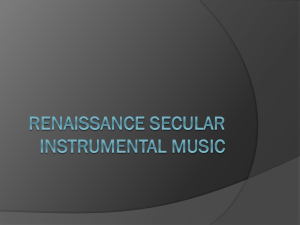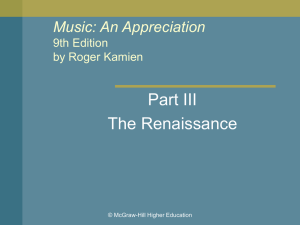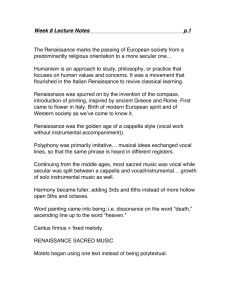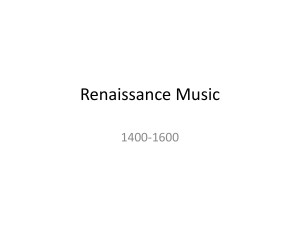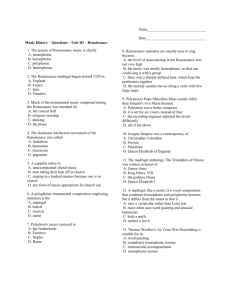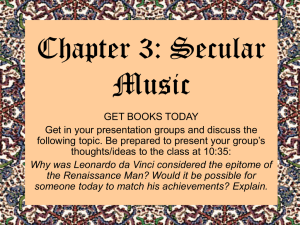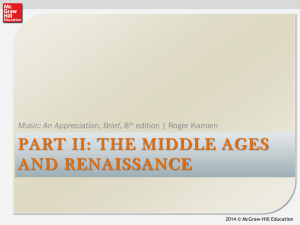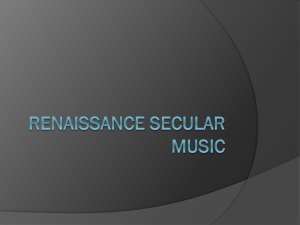Chapter 03 PowerPoint Presentations
advertisement
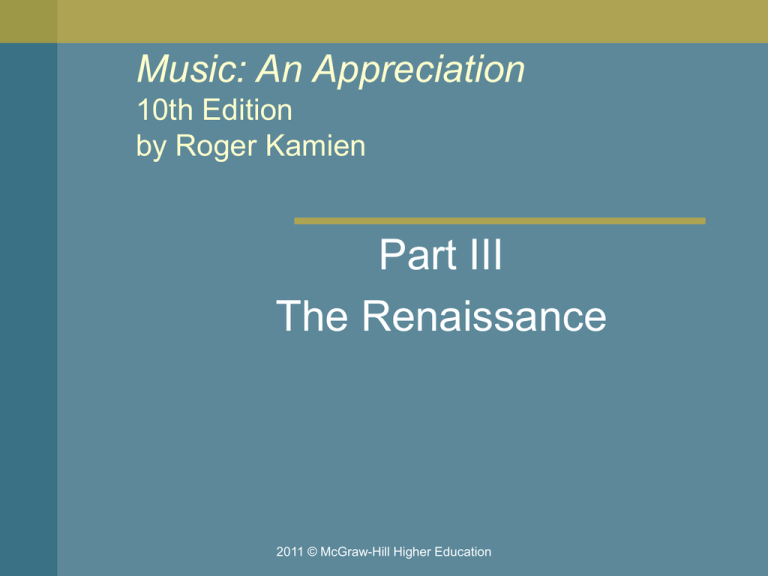
Music: An Appreciation 10th Edition by Roger Kamien Part III The Renaissance 2011 © McGraw-Hill Higher Education Time Line • Renaissance (1450-1600) • • • • • • • Guttenberg Bible—1456 Columbus reaches America—1492 Leonardo da Vinci: Mona Lisa—c. 1503 Michelangelo: David—1504 Raphael: School of Athens—1505 Martin Luther’s 95 theses—1517 Shakespeare: Romeo and Juliet—1596 The Renaissance Rebirth of human creativity Time of exploration & adventure Voyages of Christopher Columbus, Vasco da Gama and Ferdinand Magellan Age of curiosity & individualism Leonardo da Vinci Intellectual Movement – Humanism Captivated by ancient Greece & Roman cultures Visual arts depicted realism w/ linear perspective and illusion of space & depth Catholic Church far less powerful Education a status symbol for the aristocracy & upper middle class Ch. 1 - Music in the Renaissance • Invention of printing widened the circulation of music • Musicians worked in churches, courts, & towns • Church remained an important patron of music • Church choirs grew in size (all male) • Musical activity shifted to the courts • • • • Town musicians played for civic processions, weddings Musicians enjoyed higher status & pay Composers sought credit for their work Italy became leading music center Characteristics of Renaissance Music Words and Music • Vocal music more important than instrumental • Word painting • Wide range of emotion w/o extreme contrasts Texture • Polyphonic • Imitation among the voices • Sounds fuller; expanded pitch range; consonant chords are favored w/ use of triads Rhythm and Melody • Rhythm a gentle flow rather than sharply defined beat • Melodic line has greater rhythmic independence • Melody usually moves along a scale w/ few large leaps Ch. 2 - Sacred Music in the Renaissance Motet – Josquin Desprez • Short polyphonic choral work • Latin text usually overlaid with vernacular text Mass – Giovanni Pierluigi da Palestrina • Polyphonic choral composition of the Catholic church • Made up of 5 sections: • • • • • Kyrie Gloria Credo Sanctus Agnus Dei Listening Ave Maria…virgo serena Josquin Desprez Vocal Music Guide: p. 100 Basic Set, CD 1:76 Brief Set, CD 1:56 Four voice motet Polyphonic imitation Overlapping voice parts Listening Kyrie from Pope Marcellus Mass by Palestrina (1525 – 1594) Vocal Music Guide: p. 103 Basic Set CD 1:79 Brief Set 1:59 Rich polyphonic texture – 6 voices Vocal imitation Spirit of Gregorian chant Palestrina’s work became the model for mass composers Ch. 3 - Secular Music in the Renaissance Vocal Music Music was an important leisure activity People were expected to play a musical instrument and read notation Madrigal for several solo voices set to a short poem, usually about love Combined homophonic & polyphonic textures Word painting & unusual harmonies Renaissance Lute Song Song for solo voice and lute (plucked string instrument) Popular instrument in the Renaissance home Homophonic texture Lute accompanies the vocal melody Listening As Vesta was Descending (1601) by Thomas Weelkes Vocal Music Guide: p. 105 Basic Set, CD 1:82 Brief Set, CD 1:62 Madrigal Note text painting: Pitches rise on “ascending” Pitches fall on “descending” “Running down” “Two by two,” “three by three,” “all alone” Listening Flow My Tears (about 1600) by John Dowland (1563 – 1626) Vocal Music Guide: p. 106 Basic Set, CD 1:83 Brief Set, CD 1:63 Very popular Lute Song (Recorded by rock star, Sting) Expression of melancholy - descending four-note pattern Three brief musical sections: A B C Instrumental Music Still subordinate to vocal music Instrumentalists accompanied voices More music written specifically for instruments Instrumental music intended for dancing Harpsichord, organ, or lute Pavane or passamezzo in duple meter Galliard in triple meter Distinguished between loud & soft instruments Outdoor (loud): trumpet, shawm Indoor (soft): lute, recorder Ch. 4 - The Venetian School: From Renaissance to Baroque Focal point for music in Venice – St. Mark’s Cathedral Giovanni Gabrieli and the Polychoral Motet Plaudite (Clap Your Hands) Vocal Music Guide: p. 112 Basic Set, CD 2:03

